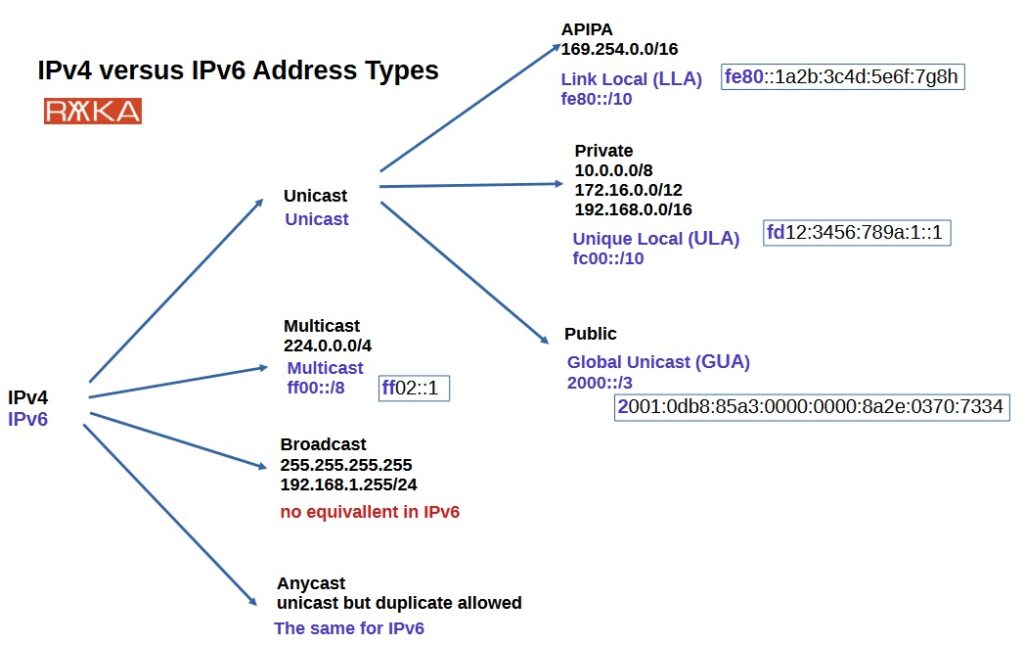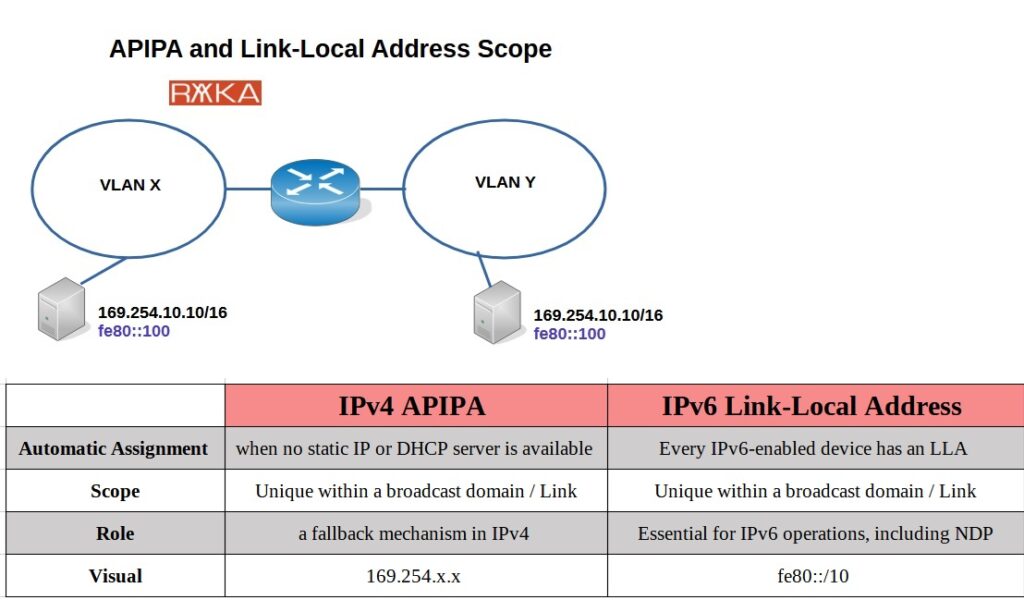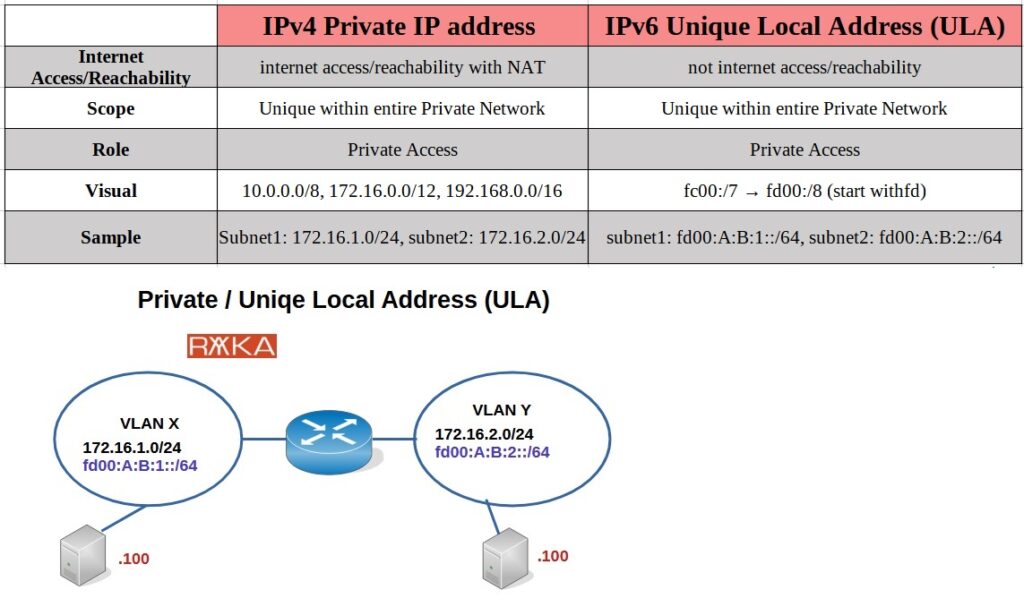In this section, we will review and compare IPv4 and IPv6 address types, focusing on the new terminologies and address ranges associated with each address type. This overview will introduce you to the key concepts, while the following sections will provide a detailed discussion dedicated to each IPv6 address type.
IPv4 versus IPv6 Address Types
This figure illustrates and compares the different types of IPv4 and IPv6 addresses side by side to enhance our understanding.
While unicast, multicast, and anycast addresses exist in both IPv4 and IPv6, IPv6 does not have a direct equivalent to the broadcast address. However, IPv6 allows you to send a packet to all nodes within a subnet using a multicast address.
APIPA / Link-Local Address (LLA)
In IPv4, there is an APIPA (Automatic Private IP Addressing) range, 169.254.x.x, which is automatically assigned to devices when no static IP address is configured and no DHCP server is available. The scope of APIPA is limited to the local subnet, VLAN, or broadcast domain, meaning that the same IP address or subnet can exist in different VLANs without conflict.
IPv6 introduces a new address type known as the “Link-Local Address” (LLA), which is somewhat similar to APIPA but far more advanced. Unlike APIPA, an LLA is always assigned to every IPv6-enabled node, even if other IP addresses are configured. LLAs are crucial for the proper functioning of IPv6, as they play a key role in the Neighbor Discovery Protocol (NDP). Without a link-local address, essential IPv6 functions, such as device communication on the same link, would not work correctly.
The primary similarity between APIPA and LLAs is that both are unique only within a single link or broadcast domain. As a result, the same IP address or subnet can exist across different VLANs, potentially even with identical addresses. However, LLAs are integral to IPv6’s core operations, whereas APIPA addresses are more of a fallback mechanism in IPv4.
A link-local address is typically generated by either creating a random number or taking it from the interface MAC address and appending it to the link-local address prefix. We will explore the details of link-local address in the upcoming sections.
Private / Unqiue Local Address (ULA)
The second type of unicast address in IPv6 is the private address, known as the Unique Local Address (ULA). This address is unique within an entire private network and is not reachable over the internet.
In IPv4, nodes with private addresses can access the internet or be reachable through Network Address Translation (NAT). However, in IPv6, nodes with Unique Local Addresses cannot reach the internet and are not reachable from the internet. Therefore, in IPv6, it is expected that all nodes requiring internet access will use a Global Unicast Address (GUA).
The IP address range for Unique Local Addresses is fc00::/7, but a subset of this range, fd00::/8, is currently used for private networking in IPv6. In other words, most IPv6 Unique Local Addresses or private addresses today start with fd.
The details of unique local address will be discussed in the follwoing sections.
Public / Global Unicats Address (GUA)
IPv4 public addresses and their IPv6 equivalent, Global Unicast Addresses (GUAs), are the most important types of addresses used on the internet. These addresses must be globally unique and are therefore assigned by a Regional Internet Registry (RIR) to a Local Internet Registry (LIR).
In IPv6, addresses in the range 2000::/3, or those starting with a “2” or “3”, are Global Unicast Addresses, which can access the internet and be reachable over the internet.
Typically, in IPv6, an LIR—such as an enterprise or service provider—is assigned a /32 prefix, and sometimes a /29 or /30. This allocation allows the LIR to create at least 2^(64-32) (two to the power of thirty-two) subnets for its own use or to allocate to its customers, effectively resolving the IPv4 address limitation.
The details of global unicast address will be discussed in the follwoing sections.
IPv4 and IPv6 Multicast address
In IPv4, multicast addresses are allocated within the range 224.0.0.0/4, covering addresses from 224.0.0.0 to 239.255.255.255. These addresses are used for multicast communication, with specific reserved addresses such as 224.0.0.1 for all nodes, 224.0.0.2 for all routers, 224.0.0.5 for OSPF, and 224.0.0.6 for OSPF.
In IPv6, multicast addresses are identified by the prefix ff00::/8, with all multicast addresses starting with ff. The IPv6 equivalents of the IPv4 multicast addresses are ff02::1 for all nodes, ff02::2 for all routers, ff02::5 for OSPF, and ff02::6 for OSPF.
A notable feature of IPv6 multicast is the “solicited-node multicast address“, which provides each node with a unique multicast address. This address is used in place of ARP requests. Instead of broadcasting ARP requests to all nodes in a network segment, IPv6 uses the solicited-node multicast address to target only the specific node whose MAC address is being requested. This approach minimizes network traffic by ensuring that only the intended recipient receives the request, similar to unicast behavior.
Further details on multicast addresses and the solicited-node multicast address will be covered in the following sections.
IPv4 Broadcast and Its IPv6 Multicast equivalent
In IPv4, each subnet has a broadcast address, which is the last address in the subnet. This address allows us to send a packet to all nodes within that broadcast domain.
For example, in the subnet with the address range 192.168.1.0/24, the last address, 192.168.1.255, is the broadcast address. It is used as the destination address when we want to send a packet to all nodes in the subnet, such as during ARP requests or DHCP operations.
In IPv6, there is no equivalent to the IPv4 broadcast address. However, we can still send a packet to all nodes within a subnet using the ff02::1 multicast address, which functions similarly by reaching all nodes in the local network segment.
In IPv4, the first IP address and the last IP address in each subnet are reserved as the network address and broadcast address, respectively. In contrast, IPv6 does not reserve any addresses in this manner. All addresses in an IPv6 subnet, including the first and last, can be assigned to nodes.
IPv4 and IPv6 anycast address
Anycast addressing is a network addressing and routing method in which multiple devices (servers or routers) share the same unicast IP address. Packets sent to an anycast address are delivered to the nearest or most optimal destination as determined by the routing protocol. This method is often used for load balancing, redundancy, and improving response times.
IPv6 provides native and explicit support for anycast addresses, allowing any unicast address to be used as an anycast address. Additionally, IPv6 defines reserved anycast addresses for specific purposes, such as the 6to4 relay anycast address (2002::/16), which is used in IPv6 tunneling migration methods.
In contrast, IPv4 does not have a specific address range designated for anycast. Instead, anycast is implemented via routing techniques without a specific address format.






